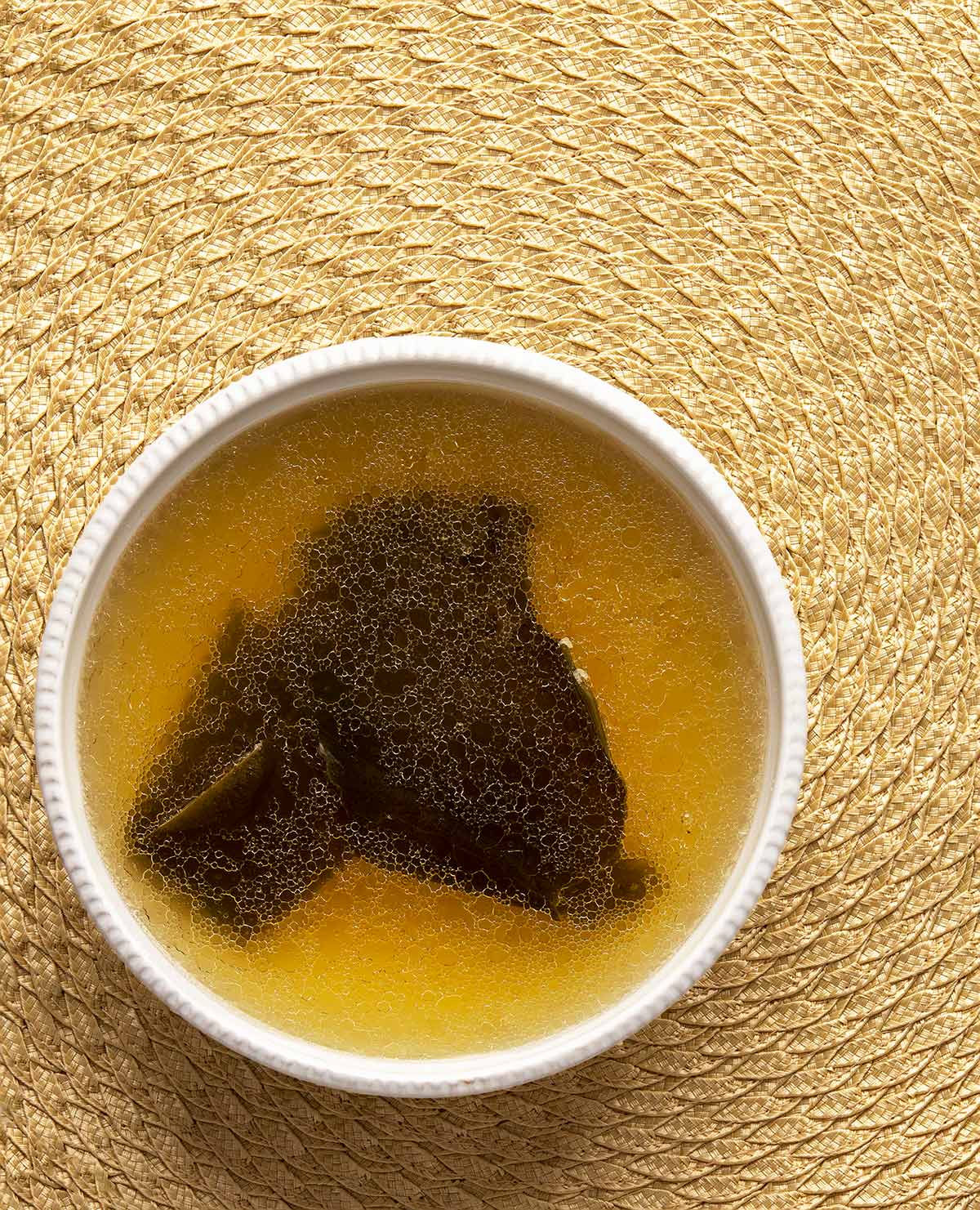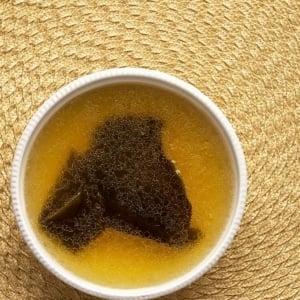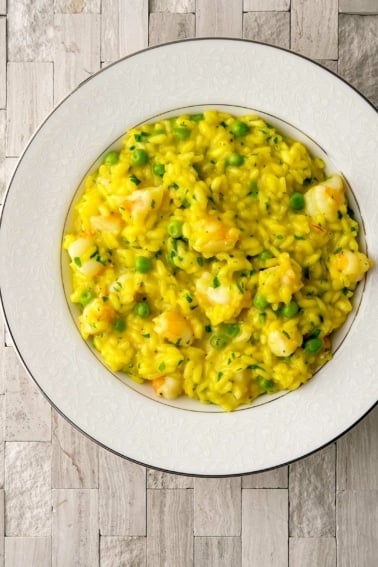As an Amazon Associate I earn from qualifying purchases.
Salmon stock is not something you really hear much about, but it’s a thing in Salmon Country, and it is really, really good when used fresh. My recipe takes a tip from Japan and uses dried kelp, but you can skip that if it’s hard to find.

First thing you need to know when making stock from salmon, trout or char is that it will be fatty. See all those pearls of omega-3 goodness in the bowl? That’s a good thing… until it isn’t. More on that in a moment.
Why make salmon stock? Because it tastes rich and wonderful, that’s why. Regular fish stock is austere, and even seafood stock or shrimp stock won’t be overly fatty, although all are wonderful in their own way.
This lovely broth is best served as part of a larger dish, notably a salmon miso soup, or Japanese salmon rice, or salmon risotto, or a salmon chowder. That said, you can drink it as a clear soup as you see in the picture.
Know that any salmonid, i.e., any species of salmon, trout or char, will work here. So whatever you catch, or buy, will do. You will want to make your salmon stock with heads and the racks.

It’s your choice to keep the meat on the bones, or scrape it off and use it for something else. Either way makes a good stock, and I will often use that “spoon meat,” which is what I call the meat scraped off the bones with a spoon, for salmon rice, or salmon cakes.
Other than the salmon, I use your typical mirepoix in my salmon stock: carrots, celery and onion. I also use a few bay leaves, and a couple lesser known ingredients: A fennel bulb or it’s tops, and sheets of kombu, which is dried kelp.
You can find fennel bulbs in most stores, and you can gather your own wild fennel in many parts of the United States. Kombu will be in the Asian aisle in many supermarkets, in all Asian markets, or you can buy kombu online. If you live by the sea, you can also gather kelp fronds that wash ashore.
What’s the point? Fennel adds a nice, if subtle, anise aroma, and the kombu adds both brininess as well as a wallop of savory umami. You will absolutely notice the difference between salmon stock made with kombu and that made without.
Think about making your salmon stock more like a tea than a soup in that you never want to let it boil. This is one of the main ways that this stuff can get nasty-fishy. The other two ways to ruin your salmon stock are cooking it for a very long time, and keeping it too long in the fridge.
I am admittedly a salmon snob. I don’t like that “salmon stink” you get a lot with not-so-fresh fish. So I make my stock and use it that day, the day after, and maybe one more time. That’s it.
But then I can always go catch another salmon. If you want to store your salmon stock, my advice is to freeze it. I have heard that people will put raw ingredients, like bones, vegetables, etc, in Mason jars and pressure can that, but I’ve never done it. Seems like it would be stinky when you used it.
So definitely, definitely use your stock the day you make it, or the day after. Then you’ll know why it’s so good.
Salmon Stock
Ingredients
- 4 to 6 pounds salmon heads and bones
- 1 fennel bulb, chopped
- 2 celery stalks, chopped
- 2 carrots, chopped
- 1 large white or yellow onion, chopped
- 2 bay leaves
- 2 to 4 ounces dried kelp
Instructions
- Cut the bones up to fit into a large pot. Add the heads, the bay leaves and all the chopped vegetables. Cover with water by one inch. Set over medium-high heat and bring just barely to a simmer. This should take a solid 15 minutes or so. Let the stock steep at the steaming point, not even simmering, for another 15 to 30 minutes, no more.
- Turn off the heat. Set a fine-mesh strainer over a large bowl. Ladle the stock through this to strain out debris, but keeping the fat. You can line the strainer with a paper towel to remove most of the fat, but it will clog repeatedly and you will need to replace the paper towel.
- Clean out the stockpot and discard the solids. Pour the broth back into the pot and set the heat to medium. Add all the dried kelp. Bring this just to a simmer, taking about 30 minutes to get there. The moment it simmers, turn off the heat and remove the kelp. Add salt to taste -- it might not need any because the kelp is salty -- and serve.
Notes
Keys to Success
- When you add heads and bones, make sure there are no gills. Gills will make a stock bitter and cloudy.
- Don't boil the stock. It will be fishy if you do. Just a bare simmer or even just steaming is what you want.
- Don't cook the stock too long, or it will be fishy. This is why you pack the pot with ingredients and just barely cover, so you get a lot of flavor in a short time.
- You can skip the whole kombu step, and you can also do it the following day. It really makes the stock better though.
- Try to use your stock within a few days. It's much nicer then. It will get fishy as it ages.
Nutrition
Nutrition information is automatically calculated, so should only be used as an approximation.






Not only do the Japanese know all about fish and shellfish stocks, they also know all about umami tastes and fishy tastes. Several things happen to fish both before it is cooked and after it is cooked to make it taste objectionable. Before cooking, bacterial enzymes and also fish enzymes present in the viscera and skin can contribute to free amines and especially trimethylamine odors. Salmon and other fatty fish also can rapidly produce metallic and strong smelling odors due to oxidization of those really healthy omega fish oils. Being highly unsaturated, these oils can rapidly oxidize and those smells are very strong and easily detected. The oxidization is greatly increased at higher temperatures and when the oils are separated from the fat and proteins due to stock making, the can go rancid in days as Hank notes. So keep your stock covered and do not boil, as it will minimize exposure to air. Also chilling it rapidly in glass jars with tight fitting lids that will produce a vacuum as the hot stock cools in an ice water bath before refrigeration can help keep it smelling fresh for the couple of days you may want to keep it. And store it very cold with a tight fitting lid on it all all times. Open it and use the entire contents at one mealtime. Freezing doesn’t work unless you can vacuum seal the stock and freeze it below the freezing point of these lipids. That requires a special -60 degree freezer for sushi quality fish freezing and that is something only high end fish processors and expensive sushi restos will have on hand. None of these tips really change Hank’s advice but just reinforce the biochemistry behind the rapid protein breakdown and lipid oxidation that all fatty fish are prone to experiencing. High quality fish starts with line caught or small net operations and no crushing the fish in huge holds with a long period before processing.
Can this be done with frozen heads and racks? Or should you make it with fresh heads and racks?
Cole: I prefer fresh, but it will work with frozen, although it might be a little fishier.
Not sure if it adds much but I like to use a clever to slice the heads lengthwise. I like the idea of the addition of kelp have to give it a try.
Great tips- I am going to try this out. I am curious, though- how do you cook with the stock if you can’t let it boil? If I plug it into my next recipe instead of bouillon, do I have to maintain it at a barely simmering temperature?
Anna: To be honest, you can let it boil, but the stock will get cloudy, and if you let it boil too long it will get bitter. Also, salmon stock is very perishable, so I would make it and use it within 3 days, and I personally don’t store it longer because it can get fishy.
Tried this immediately with a wonderful delicate result. Even with frozen bones and veggies it worked beautifully. Thanks for this method!
Ahh. Salmon stock. So delicious. So ephemeral. I’ve tried all manner of preserving it, and it’s just not good enough to be worth it. Canning: gross; freezing heads and frames: nope, gross too; freezing prepared stock: okay, but fish stock from the store is probably better and significantly less work. It’s a bummer because up here in Alaska most of the salmon fishing I do is mid summer and during the very short time of the year I don’t want to eat soups. If anyone has found some sort of voodoo to keep it longer than a few days, I’d sell a large portion of my remaining soul.
I’ll absolutely admit that freshly made is the best, hands down. I am another who does not tolerate fishy taste. But perhaps my palate does not notice subtlety. I slow simmered my sockeye heads and frames this year (25 salmon) for 12 hours, strained, then pressure canned the broth and stock ingredients separately. I’ve not used a jar of broth yet. I did prepare a lovely stew/soup from one jar of stock ingredients and to me it was not fishy. So good and still so full of omega-3s. I practically inhaled it. I will give your method a try sometime, and see if I notice the difference.
Would it work to have the Kombu in with the solids, or is the separate step necessary for other reasons?
Cleve: The separate step is because kombu doesn’t want to be simmered. You get the best effect when it starts in a cool or room temp liquid that is then brought to a simmer for a moment, then the heat is turned off.
How could the pressure cooker be used?
Lowandslow: Pressure can as you would any stock, which is to say 10 psi if you live at 1000 feet of elevation or below, for 25 minutes for quarts. You certainly can do this, but in my opinion it makes the stock stinky-fishy.
In Eastern European salmon stock recipes, especially when making the Jewish gefilte fish, I learned to use onion skins in the stock instead of bay leaves. It tastes much better